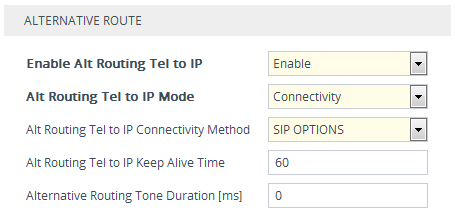Alternative Tel-to-IP Routing Based on IP Connectivity
You can configure the device to route Tel-to-IP calls to an alternative IP destination when the connectivity state of an IP destination is unavailable. The alternative routing rules are configured in the Tel-to-IP Routing table. These rules must be configured anywhere below the "main" routing rule and with identical matching characteristics (e.g., destination prefix number) to the "main" routing rule. The device uses the first alternative route that is available. For more information on configuring alternative Tel-to-IP routing rules in the Tel-to-IP Routing table, see Configuring Tel-to-IP Routing Rules.
| ● | Alternative routing based on IP connectivity is applicable only when a proxy server is not used. |
| ● | You can also enable the Busy Out feature, whereby the device can take specified actions if all IP destinations of matching routing rules in the Tel-to-IP Routing table do not respond to connectivity checks. For more information, see the [EnableBusyOut] parameter. |
| ● | If you enable the [AltRoutingTel2IPEnable] parameter, the Busy Out feature doesn't function with the Proxy Set keep-alive mechanism (see Alternative Routing Based on SIP Responses). To use the Busy Out feature with the Proxy Set keep-alive mechanism (for IP Groups), disable the [AltRoutingTel2IPEnable] parameter. |
The device searches for an alternative routing rule (IP destination) when any of the following connectivity states are detected with the IP destination of the "main" routing rule:
| ■ | No response received from SIP OPTIONS messages. This depends on the chosen method for checking IP connectivity. |
| ■ | Poor QoS according to the configured thresholds for packet loss and delay. |
| ■ | No response from a DNS-resolved IP address, where the domain name (FQDN) is configured for the IP destination. If the device sends the INVITE message to the first IP address and receives no response, the device makes a user-defined number of attempts (configured by the [HotSwapRtx] parameter) to send it again (re-transmit). If there is still no response after all the attempts, it sends it to the next DNS-resolved IP address, and so on. For example, if you configure the parameter to "3" (without quotation marks) and the device receives no response from the first IP address, it attempts up to three times to send the INVITE to the first IP address and if unsuccessful, it attempts to send the call to the next DNS-resolved IP address, and so on. |
| ■ | No response for in-dialog request from a DNS-resolved IP address, where the domain name is received in the Contact header of an incoming setup or target refresh SIP message (e.g., 200 OK). If no response is received from the first IP address, the device tries to send it again for up to a user-defined number of attempts (configured by the [HotSwapRtx] parameter). If there is still no response, it attempts to send the SIP request to the next DNS-resolved IP address, and so on. |
The connectivity status of the IP destination is displayed in the 'Status' column of the Tel-to-IP Routing table per routing rule. If it displays a status other than "ok", the device considers the IP destination as unavailable and attempts to re-route the call to an alternative destination. For more information on the IP connectivity methods and on viewing IP connectivity status, see IP Destinations Connectivity Feature.
The table below shows an example of alternative routing where the device uses an available alternative routing rule in the Tel-to-IP Routing table to re-route the initial Tel-to-IP call.
Alternative Routing based on IP Connectivity Example
|
|
Destination Phone Prefix |
IP Destination |
IP Connectivity Status |
Rule Used? |
|---|---|---|---|---|
|
Main Route |
40 |
10.33.45.68 |
"No Connectivity" |
No |
|
Alternative Route #1 |
40 |
10.33.45.70 |
"QoS Low" |
No |
|
Alternative Route #2 |
40 |
10.33.45.72 |
"ok" |
Yes |
The following procedure describes how to configure alternative Tel-to-IP routing based on IP connectivity.
| ➢ | To configure alternative Tel-to-IP routing based on IP connectivity: |
| 1. | In the Tel-to-IP Routing table (see Configuring Tel-to-IP Routing Rules), add alternative Tel-to-IP routing rules for specific calls. |
| 2. | Open the Routing Settings page (Setup menu > Signaling & Media tab > Gateway folder > Routing > Routing Settings): |

| 3. | Under the Alternative Route group, do the following: |
| a. | From the 'Enable Alt Routing Tel to IP' [AltRoutingTel2IPEnable] drop-down list, select Enable to enable alternative Tel-to-IP routing based on IP connectivity. |
| b. | From the 'Alt Routing Tel to IP Mode' drop-down list [AltRoutingTel2IPMode], configure the IP connectivity reason for triggering alternative routing. |
| ◆ | Connectivity: Alternative routing is performed if SIP OPTIONS message to the initial destination fails |
| ◆ | QoS: Alternative routing is performed if poor QoS is detected. QoS is quantified according to delay and packet loss calculated according to previous calls. |
| ◆ | Both (above) |
| a. | Enable the connectivity feature (see IP Destinations Connectivity Feature). |